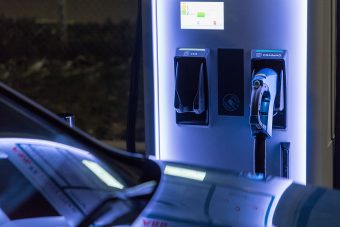
A few years ago, the management of the public enterprise “Roads of Serbia” recognized the necessity of introducing electric vehicles to the Serbian transport system.
Just before the end of 2018, a proposal by the toll collection sector of this public company was sent to the Ministry of Construction, Transport, and Infrastructure to prescribe the procedure for installation of electric chargers, which were previously omitted both by the Law and the Rulebook.
Our interlocutor, Mr Darko Savić, Deputy Executive Director of the Toll Collection Sector within the PE “Roads of Serbia”, told us that his company had already installed five EV chargers in 2017. These chargers are installed at strategic key points along highways, i.e., when entering our country from abroad.
All those who traveled to neighboring countries must have noticed the EV chargers located at toll stations “Preševo”, “Šid”, “Dimitrovgrad”, “Subotica”, as well as at the central location in our country, in the area of the former toll station “Belgrade” near Bubanj Potok.
In focus:
Five years ago, the installed EV chargers were the latest EV charging solution offered by global manufacturers. They all have three connectors: two for fast DC charging and one for AC charging. These stations allow fast charging of electric vehicles, including the next generation of electric cars.
Maximum output power is 50 kW for DC and 22 kW for AC charging. At the beginning of last year, the public enterprise “Roads of Serbia” installed three ultra-fast electric chargers with 175 kW of power. One of them is located at the toll station “Belgrade”, along the Niš – Belgrade route, while the remaining two are on the plateau of the former toll station “Niš” – one in the direction of Belgrade, and the other in the opposite direction, towards Niš.
Characteristics of ultra-fast chargers at toll plazas
The 175 kW DC charger model, manufactured by the world-renowned company ABB, is a fast charger consisting of a vertical power cabinet of modular type and a charging port. The maximum DC output power of the device is 175 kW. The flexible design allows multiple types of connectors such as CCS and CHAdeMO. This charger was designed based incidental charging and is suitable for toll stations, rest areas on highways, or gas stations.
“These chargers are designed to work outdoors at temperatures ranging from -30 to +50 ˚C with mechanical shock protection and the ability to connect to the GSM/2G/3G modem/4G network and 10/100 Base-T Ethernet”, explained Mr Savić and added that the new electric chargers meet all required standards and are suitable for the actual and next generation of electric vehicles.

All chargers have an interface that allows you to connect the charger to a system/fiscal platform for charger use. Presently, three new ultra-fast chargers are connected to the Charge&GO platform, the first regional digital platform for charging electric vehicles.
Through this application, the platform enables monitoring and management of the charger system and payment for charging (when the legal requirements are met). Darko Savić states that the Charge&GO platform provides charger visibility on global platforms, allowing application users insight into charger occupancy, the possibility of charging for electricity used, and many other benefits (possibility of editing charging prices, etc.).
“The plan is to place the existing five chargers on the same platform, which would give us a significant network of chargers on public roads, visible on the world’s leading applications such as Plug&Share, Virta, ChargePoint”, said Mr Savić.
Prepared by: Milica Radičević
Read the story in the new issue of the Energy portal Magazine ELECTROMOBILITY.

